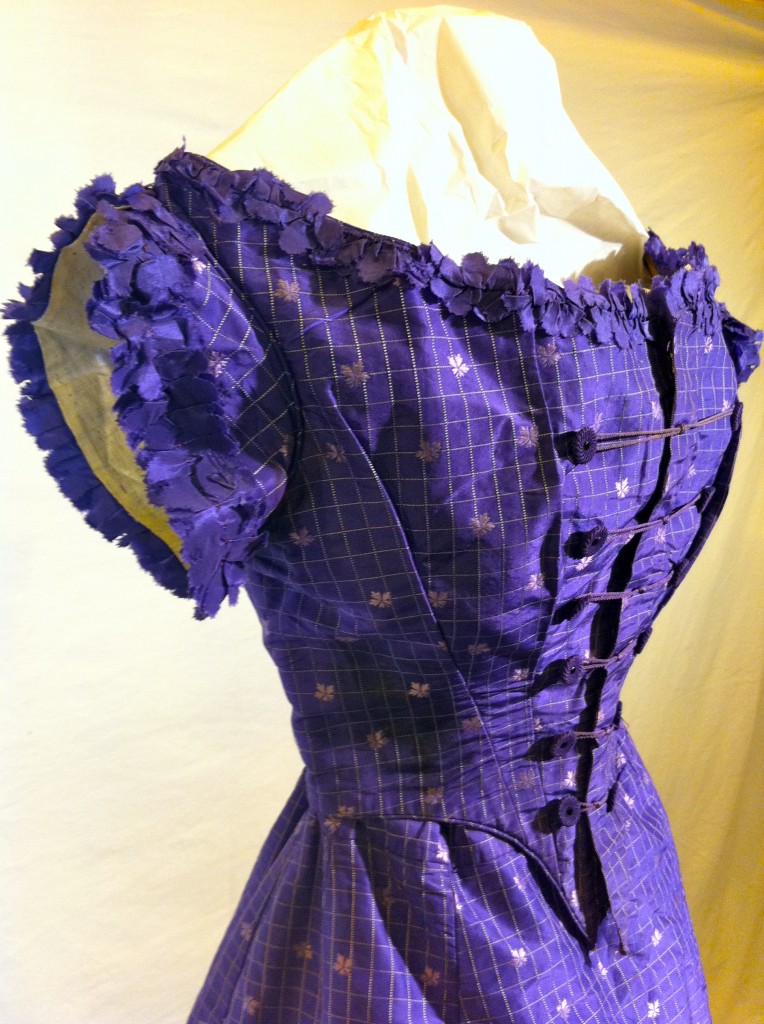Life on the American frontier meant countless hardships. Many people living in what are now states like Idaho, Montana and Utah homesteaded and relied mostly on themselves for everyday things like clothing, food and housing. Being self-sufficient, out of necessity, meant that many frontier brides had to sew their own dresses or wear a dress handed down from relatives or neighbors. Also, fabric was not easy to come by since many people lived in small communities far away from merchants or postal stations where they could purchase fabrics. Thus, most wedding dresses on the frontier were simply “best” dresses. Frontierswomen often wore their “best” dresses for multiple occasions such as weddings, funerals, church gatherings, etc. A frontier bride did not only wear this dress for her wedding, but throughout her life and probably loaned out to other women when needed, or passed down to relatives and children8. When thinking about the American frontier it is easy to assume that it was not the cleanest environment. Old photographs often show dirt streets and dusty homesteads, even the people in the photographs sometimes appear with dirty shoes and even dirty clothes.
We have learned that people living in the frontier did not have easy access to materials like fabric, leaving their wardrobes minimal and consisting of only a few necessary articles of clothing. We have also learned that frontierswomen often wed in their “best” dress, a dress to be worn on multiple occasions throughout her life.

This dress, made and worn by Mrs. Louis Dibble, exemplifies versatility in a woman's "best" dress. This photo shows the dress with it's accompanying jacket. A later photo shows the dress in it's short-sleeve form. Mrs. Dibble wore this dress on a boat sailing around Cape Horn for her wedding, June 8, 1863. Image courtesy of Idaho State Historical Society. Catalog # 1971.119.3/1-3
Lastly, we have learned that living on the frontier meant living in a rather dirty environment. Knowing all of that it is not surprising to learn that many frontier brides did not wear white dresses on their wedding day. Color became very important in the evolution of dressmaking during the Victorian Era9. In more industrialized locations, such as London and New York, white did not seem as impractical as it did in the West. However, the use of color served a practical purpose for women in the West, as choices in clothing and the maintenance needed for white fabrics were not as accessible. In fact, many surviving dresses are different shades of brown, grey and even black. Some are more aesthetically pleasing colors, like periwinkle or velvety red, but very few are white.

Vibrant fabrics such as the dense periwinkle cotton used in this dress helped hide dirt -- better than white -- and provided customization for women. Image courtesy of Idaho State Historical Society. Catalog # 1971.119.3/1-3
White, as is still believed today, is a difficult color to keep clean. Think about life in the 19th century American frontier: clean water to wash clothing with was not common, brides wed in a dress that had to be worn more than once and the surrounding environment did not accommodate anything white. Thus, wedding dresses of the American frontier were rarely white.
For the sake of practicality, frontierswomen’s wedding dresses differed in many ways to the Victorian fashions of most of the 19th century. While the dress cuts may have been accommodating to the modesty of Victorianism, the colors and styles were more practical for life on the American frontier. Now that we understand the historical context of Victorian fashion and the practicality of the American West, we will now explore the technology used to craft these dresses.
ENDNOTES
8. Sandra H. Luebking. “Your Search for U.S. Marriage Records.” Ancestry: A Family History Source from Amcestry.com 20; 3 (2002): 26. Accessed May 1, 2012. http://books.google.com/books?id=gn_YSif8RLEC&pg=PA26&dq=history+of+american+frontier+wedding+dresses&hl=en&sa=X&ei=M76iT-glpeSIAvyCqdgH&ved=0CEMQ6AEwAA#v=onepage&q=history%20of%20american%20frontier%20wedding%20dresses&f=false
9. Hackettstown Historical Society. “Fashion in the Victorian Era.” Accessed May 4, 2012. http://www.hackettstownhistory.com/narticle_fashion.shtml.